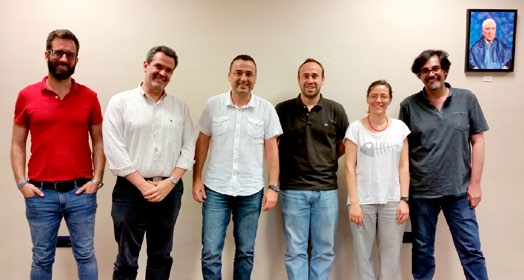News in the Media
Short link: http://u.uma.es/gjr/
-
Crean un nuevo sistema de alerta de tsunamis reconocido internacionalmente
El grupo EDANYA gana el premio `NVIDIA 2018´ por su trabajo en simulación de tsunamis
RED ESTRATÉGICA MATEMÁTICAS: https://institucionales.us.es/remimus/el-grupo-edanya-miembro-de-math-in-gana-el-premio-nvidia-2018-por-su-trabajo-en-deteccion-de-tsunamis/
-
Un grupo de investigación de la UMA, primer equipo europeo que consigue el galardón 'NVIDIA'
UNIVERSIDAD DE MÁLAGA: https://www.uma.es/sala-de-prensa/noticias/un-grupo-de-investigacion-de-la-uma-primer-equipo-europeo-que-consigue-el-galardon-nvidia/
Un grupo de investigación de la UMA sobre simulación de tsunamis en tiempo real, premiado con 100.000 dólares
Un estudio de la UMA sobre tsunamis logra un galardón internacional dotado con 81.000 euros
DIARIO SUR: http://www.diariosur.es/universidad/estudio-sobre-tsunamis-20180402154100-nt.html#ns_campaign=gs-ms&ns_mchannel=diariosur&ns_source=fb&ns_linkname=ltl
El programa de la UMA para simular los efectos de un tsunami en tiempo real, premiado
LA OPINIÓN DE MÁLAGA: http://www.laopiniondemalaga.es/malaga/2018/04/02/programa-uma-simular-efectos-tsunami/997072.html
El modelo que simula los efectos de un tsunami logra galardón internacional
LA VANGUARDIA: http://www.lavanguardia.com/vida/20180402/442140593234/el-modelo-que-simula-los-efectos-de-un-tsunami-logra-galardon-internacional.html
Premian con 100.000 dólares a un grupo de investigación de la UMA sobre tsunamis
MÁLAGA HOY: http://www.malagahoy.es/malaga/Premian-dolares-investigacion-UMA-tsunamis_0_1232577330.html
Un grupo de investigación de la UMA sobre simulación de tsunamis en tiempo real, premiado con 100.000 dólares
20 MINUTOS: https://www.20minutos.es/noticia/3302836/0/grupo-investigacion-uma-sobre-simulacion-tsunamis-tiempo-real-premiado-con-100-000-dolares/
-
Un estudio de la UMA sobre tsunamis, finalista en unos premios a nivel internacional
DIARIO SUR - CRÓNICA UNIVERSITARIA: http://www.diariosur.es/cronica-universitaria/estudio-sobre-tsunamis-20180320000730-ntvo.html
-
Tsunamis controlados desde Málaga
LA OPINIÓN DE MÁLAGA: http://www.laopiniondemalaga.es/malaga/2018/03/17/tsunamis-controlados-malaga/993785.html
-
El grupo 'EDANYA' miembro de math-in, finalistas en los galardones 'NVIDIA 2018'
-
El grupo EDANYA llega a la final de los premios ‘NVIDIA 2018’
AULA MAGNA: http://www.aulamagna.com.es/el-grupo-edanya-llega-a-la-final-de-los-premios-nvidia-2018/
-
El grupo de investigación 'EDANYA' de la UMA, uno de los cuatro finalistas en los galardones 'Nvidia 2018'
El grupo de investigación 'EDANYA' de la UMA, uno de los cuatro finalistas en los galardones 'Nvidia 2018'
Nvidia A team of researchers at the University of Málaga are using #GPUs to advance capabilities of tsunami early warning systems and aim to save lives and prevent damage. They are finalists for the NVIDIA 2018 Global Impact Award, which provides $200,000 to researchers using our technology for groundbreaking work that addresses social, humanitarian and environmental problems. #socialimpact
INSTAGRAM: https://www.instagram.com/p/BgPZzT-nz1c/
-
Instituto Geográfico Nacional IGN

Simulación de propagación de tsunami en tiempo real – TSUNAMI-HySEA Link
En febrero de 2015, la Universidad de Málaga (UMA) y el Instituto Geográfico Nacional (IGN) firmaron un acuerdo de colaboración para trabajar en el desarrollo y puesta a punto del Sistema Nacional de Alerta Temprana de Tsunami en materia de simulación de propagación de la ola. A partir de entonces, el IGN ha adquirido el hardware necesario para poder implantar un nuevo software que ha revolucionado este tipo de simulaciones en alerta por tsunami. Los investigadores del IGN, después de realizar la compleja configuración del hardware, se reunieron en dos jornadas de trabajo en la Facultad de Ciencias de la UMA con el Grupo de Ecuaciones Diferenciales, Análisis Numérico y Aplicaciones (EDANYA) para realizar la instalación del software y su configuración. Así, desde el 5 de junio el IGN puede calcular in situ la propagación de un tsunami utilizando este código matemático ideado por los investigadores de la UMA, que permite la simulación de tsunamis en tiempo real. “Tsunami-HySEA”, utiliza algoritmos matemáticos de gran eficiencia computacional, muy robustos, que se han implementado en arquitecturas GPU (en tarjetas gráficas de las que emplean los ordenadores y videojuegos). Características de vanguardia que le permiten realizar simulaciones de la evolución de un tsunami en todo el Mediterráneo en 6 minutos. Esta simulación, que hasta ahora tardaba varias horas si los mismos cálculos se realizaran en una CPU convencional (procesador estándar de un ordenador), convierten al código de la UMA en una herramienta única y privilegiada para la alerta.
-
Jorge Macías, matemático:
“Para simular 10 segundos de tsunami hay que resolver más de 3.000 millones de incógnitas”NOBBOT: https://www.nobbot.com/personas/entrevista-jorge-marcias-matematico-edanya/
-
Entrevista
Radio Aragón - Programa la Cadiera



